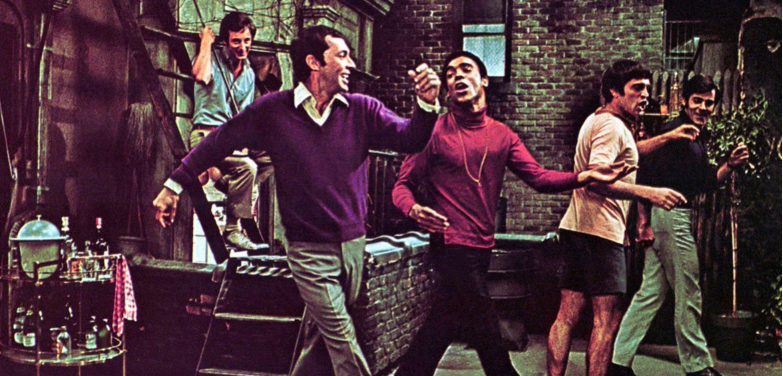| Collier White |

Those two years make all the difference. Turning 49 this year, The Boys in the Band is a work that has straddled Stonewall for its entire life. You might be surprised at how fresh she sounds. You’ll want to rush out and see it before it’s cancelled again, because this is a truly wonderful film, an ensemble of unforgettable performances, and a film that divides opinion and continues to pit friend against friend, just like the cruel party game at its heart.
So much has been written about the queer politics of The Boys in the Band that the discussion threatens to dessicate the film’s more universal qualities. In much of the criticism of the film, a division is imposed, pitting broad humanism against identity politics. Writer Mart Crowley boldly rejected the notion that mainstream audiences wouldn’t care about a play comprised primarily the banter of eight gay men. Some assumed that interest in this gay lifestyle play would be merely prurient. Yet in 2019, The Boys in the Band looks both more politically relevant and more universally humane than that other party that devolves into shouting, Who’s Afraid of Virginia Woolf?, which Mart Crowley admits inspired him to write this very personal story.
Mart Crowley’s play was first produced in 1968 to immediate acclaim and popularity, but by the time the film debuted in 1970, questions about representation impacted its critical reception. A year after Stonewall, did the queer movement need a chamber piece about nine self-loathing queens? As American gay politics began parading under a banner of pride, Crowley’s self-flagellating play was out of step. Tastemakers forced Crowley’s boys back into the closet just as William Friedkin’s film was debuting in art houses across the country.
Fifty years later, vulnerability is almost synonymous with strength, and we find the play and movie are as juicy as ever. As a film, The Boys in the Band retains many of the elements that made it a great play, with Friedkin masterfully emphasizing character dynamics and internal struggle. This may surprise casual filmgoers, for whom Friedkin is synonymous with genre pictures. Following The Exorcist (1973), one of his greatest successes, with the misleadingly titled Sorcerer (1977) killed his reputation twice. First, Friedkin was erroneously labeled a genre picture director. Secondly, audiences who went to Sorcerer expecting a horror or fantasy experience were bored by the slow-drip terror of four damned men in a Sartrean drama of a dirty hell on earth. To call Friedkin a genre director is like saying Hemingway is a war novelist after reading A Farewell to Arms. Whatever you think of the iconoclastic Hemingway’s men, they endure because they evoke rich character and story with just a few strokes of dialogue. While The Exorcist may not have aged well as a horror film, it’s still a knockout as a movie about a conflicted priest. Part of that is pure technique.
Friedkin’s attention to characterization is in full effect in Boys. After briefly meeting the eponymous boys on the street in the middle of preparing for a birthday party, Boys moves to Michael’s New York apartment and stays there. The apartment—borrowed from actress Tammy Grimes and partially recreated on a soundstage—has indoor and outdoor parts, both of which feel like safe spaces. For a while, the banter and the cinematic jibes and jeers—some borrowed, some broken—seem unable to find purchase on the convivial houseguests until the outside is allowed to intrude in the character of Allen (Peter White), Michael’s ostensibly straight old college chum. Shortly after his unannounced arrival, Allen punches the effeminate Emory, (Cliff Gorman in a role so convincing that it almost typecast the actor, who would later come to be known as a tough guy, as a screaming queen). As Michael is forced to contenance a gay bashing in his own home, he breaks his sobriety just as the guest of honor, the misanthropic retired figure skater Harold (Leonard Frey) arrives. Just as boys of a certain kind will mix it up with fistfights and wrestling after a few drinks, the gay bloodsport here is a mixture of cruel insults and unqualified psychoanalysis that cuts to the bone.
Friedkin’s close-ups hold the characters a little longer. In Boys’ party scenes, his camera captures two or five or eight people playfully sparring. By the end of this film, we know these characters as well as any in any film. We want to stay with them longer—I can’t say the same of the characters in Albee’s play.
All of the actors in the film identified as straight, but there were open secrets about their sexuality, and five of them had died of complications from AIDS in the twenty years after its release. Their deaths makes the film all the more poignant: it is a document of a moment and an expression of a feeling, evoking nostalgia while remaining timeless. Through the lives of these particular characters, the audience is exposed to a specific dramatic tale and also to self-loathing more generally. The Boys in the Band connects us to the terms with which we identify ourselves and to the things we can’t admit—or only admit when it’s too late—and reminds us that life is fleeting, that our honesty can be deployed cruelly or courageously, and that forgiveness has a special grace.
Edited by Shivaun Watchorn and Michelle Baroody
The Boys in the Band plays at the Trylon starting on Friday, June 14. Visit the website to purchase tickets or for more information. Make it a double feature and check out Rob Epstein and Jeffrey Friedman’s The Celluloid Closet.
